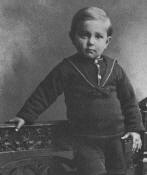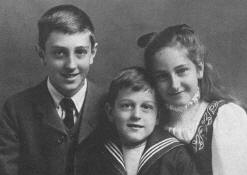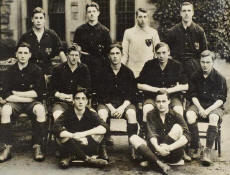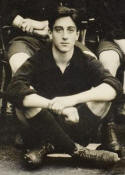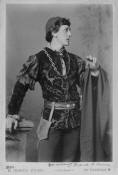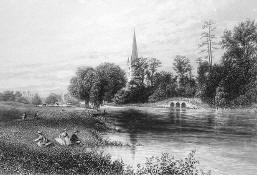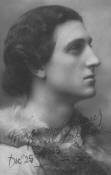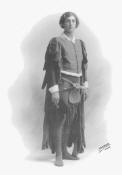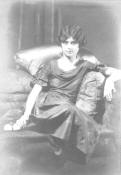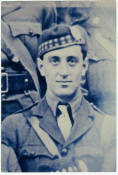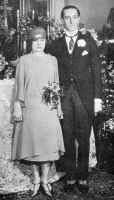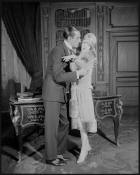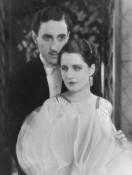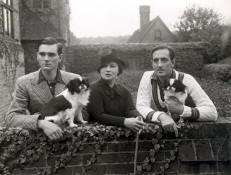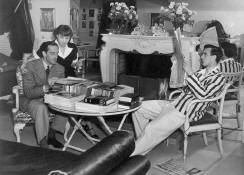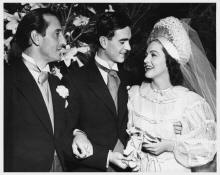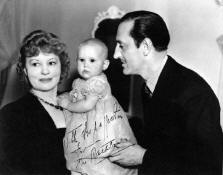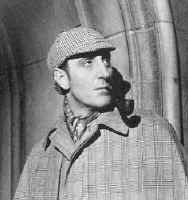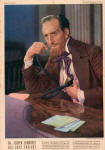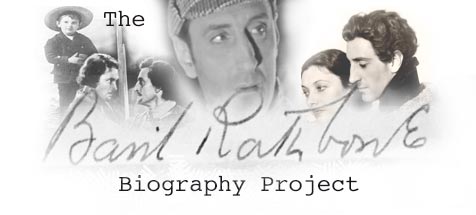The Life of
Basil Rathbone Growing Up Philip St. John Basil Rathbone's life began on June 13, 1892, in Johannesburg, South Africa. In 1895 his family had to flee to escape the Boers because Rathbone's father was accused of being a British spy. In his autobiography Rathbone admits that he didn't know whether or not his father really was a spy—he had never asked his father! What is known is that his father, Edgar Philip Rathbone, was a mining engineer, and his mother, Anna Barbara Rathbone, a violinist. Basil was the eldest of three children. He had a younger sister Beatrice and a younger brother John.
Rathbone grew up in England and attended the Repton School* from 1906 to 1910. More interested in sports than studying, Rathbone (called "Ratters" by his friends) excelled in sports. While at school, he developed a love of the theater.
*To learn more about Repton School, visit www.repton.org.uk/. When he left school, Basil told his father he wanted to make the theater his profession. His father persuaded him to agree to work for one year at an insurance company (and hoped that Rathbone would forget about the theater.) After the obligatory year, Rathbone visited his cousin Frank Benson, an accomplished actor and manager of his own company. Cousin Frank gave him a job, but did not bestow favors upon him. Rathbone had to learn acting and earn the good parts. Rathbone started acting in the No. 2 company, but by 1913 he had been promoted to the #1 company and was playing all the juvenile leads.
Marriage
World War I
After his return from the war, Rathbone's theatre career picked up and he performed in Stratford on Avon, and in London. His marriage, however, broke up. Rathbone chose not to reveal why this happened—it just did. He left Marion and his son Rodion, and set up house on his own. Although he was not making much money, Rathbone struggled to pay for two households. He did not want his wife and son to suffer financially because of his decision to leave them. During this time Rathbone wrestled with a sense of guilt with regard to his son. He writes: "Self-condemnation fought bitterly with self- justification, and there was no one to turn to and talk with about such intimate personal matters. ... my son was missing his father" (In and Out of Character, page 17). Henry Daniell (who later played Moriarty
in The Woman in Green, one of the
Sherlock Holmes films) was a fellow actor at that time. Rathbone acted in
many
Shakespeare plays then, and loved many different women. To read more about
the women, see
The Women in Basil Rathbone's Life. New York The next phase of Basil Rathbone's career began in 1923, when he came to New York City
to perform in The Swan. In November of that year, Rathbone met Ouida Bergere,
a scriptwriter. They fell in love and made plans to marry. Before that could happen,
however, Rathbone needed to get a divorce from Marion Foreman. They had
separated in 1919, but had not divorced. In a 1940 interview for True
Story magazine, Rathbone
explained, “I came from an old-school family which did not believe in divorce. … When
a Rathbone married, he stayed married, regardless of the circumstances.
They had barely forgiven me for taking up acting as a profession. I knew
all too well what their reaction to a divorce would be.” He traveled back to England
for that purpose, and also saw his father for the last time. Rathbone's father died on
June 13, 1924. Basil and Ouida were married on April 18, 1926, in New York. Their marriage was by most accounts a very happy one, and lasted until Rathbone's death in 1967. They shared a love of reading books and watching boxing. Both of them thought that Sugar Ray Robinson was wonderful. Basil was also a baseball fan and an enthusiastic golfer. Although he tried, Rathbone never succeeded in getting Ouida interested in golf. To learn more about Ouida, see this page: Ouida Bergere Rathbone.
From Theater to Films During the 1920s most of Basil Rathbone's work was in the theater. Many of his Broadway roles were that of the suave, sophisticated seducer of women—so different from the Baker Street detective he played later in his career! One of these plays, The Captive, caused Rathbone to be arrested. Rathbone was cast in the role of Jacques, a young man engaged to be married. In the play Jacques discovers that his fiancée is in love with someone else—a woman! Since homosexuality was such a controversial topic during the 1920s, the entire cast was charged with offending public morals, and the play was closed. The charges were eventually dropped, but Rathbone was very angry about the censorship. He and many others involved with the play felt that The Captive was a great play, which addressed an issue important to society, something people needed to know about.
Rathbone made eight films during the
1920s. The Last of Mrs. Cheyney was a
great success in 1929 and made film producers sit up and take notice of Rathbone. He was
in demand for several films after that and also continued to do stage plays in the early
1930s. Rathbone made seven films in 1930 alone! He also made three films in England during
1933. The Rathbones finally moved to Hollywood in 1935. The Hollywood Years The Rathbones gained a reputation for throwing lavish (and expensive!) parties, which the biggest stars in Hollywood attended. At one such party Errol Flynn got drunk, followed a young lady home and passed out on her living room sofa. Later that night, the woman's father brought the unconscious Flynn back to the Rathbone's house and dumped him on the lawn. "The next morning, Basil and Ouida were having breakfast on the patio, when the gardener turned on the sprinklers. Who should spring up from the grass, but a hung-over Errol Flynn. The Rathbones sat—mouths agape—as Errol bid them a cheery 'Good morning,' then departed for home." (quoted in Basil Rathbone: His Life and His Films, page 21) Rathbone made many great films during the 1930s. In most of them he played the role of the villain, including one of his best-known roles: Sir Guy of Gisbourne (The Adventures of Robin Hood). The swashbuckling adventure roles were the most fun for Rathbone, and he trained to become an accomplished swordsman. "I enjoyed swordsmanship more than anything because it was beautiful. I thought it was a wonderful exercise, a great sport. But I would not put it under the category of sport; I would put it under the category of the arts. I think it's tremendously skillful and very beautiful. . . . The only actor I actually fought with on the screen was Flynn, and that's the only time I was really scared. I wasn't scared because he was careless but because he didn't know how to protect himself" (quoted in Castle of Frankenstein, 1969 issue, pages 31-32). During his film career, Rathbone was twice nominated for an Academy Award in the category of Best Supporting Actor. One was for the role of Tybalt in Romeo and Juliet and the other was for the role of the king in If I Were King. Both times the award went to Walter Brennan instead of to Rathbone. In the late 1930s, Rathbone's son Rodion joined the family in Hollywood and lived with them for a year. It appears that Rathbone tried to keep in touch with his son over the years and visited him when he was in England. Rathbone spent a few months in England in the summer of 1931. He returned to England in June 1932 and stayed until October 1933. This photo below of Rodion, Ouida, and Basil was taken at the guest house in Penn, Buckinghamshire.
Rodion even appeared in two films with his father: He played the role of Russell (a young pilot) in The Dawn Patrol and Lord DeVere in The Tower of London. He also worked in the studio's technical department. Late in 1937, Rodion met Caroline Fisher, a drama student, on a motion picture set. They were married the following spring. Ouida Rathbone staged a grand Hollywood wedding reception for Rodion and Caroline in the garden of the Rathbone home. All the Hollywood stars came to the party and the movie fan magazines published photos of the celebrities at Ouida's recent event. Rodion and Caroline felt that they should have been the center of attention at their own wedding, and not just part of the background. Ouida felt that Rodion and Caroline should have been grateful to her for all her hard work in planning and executing this wonderful wedding reception for them. This difference of opinion led to an unfortunate blowup between Rodion and Caroline on one side, and Ouida and Basil on the other side. They exchanged words that led to Basil saying, "I never want to see you again." As a result, Rodion and Caroline left the Rathbone household, and moved to Chicago. When Britain entered World War II, Rodion went to flying school in Windsor, Ontario. He trained to be a pilot in the Royal Canadian Air Force. And, except for one occasion two decades later, Rodion did not see his father again. Sadly, Rodion's children did not have a relationship with their grandfather.
A newspaper article dated June 22, 1939, announced that the Rathbones adopted a baby girl when she was 11 weeks old). The article mentioned that their own baby died 11 years ago (1928). Basil and Ouida named their baby Cynthia. By all accounts, Rathbone was
a very devoted father and spent a lot of time with his daughter. When Cynthia was older
she even accompanied her father on his summer stock tours. The War Years In 1939 England declared war on Germany. Rathbone wished to serve his country, but due
to his age (47), the war office in London turned him down. So, Basil spent the war years
serving as President of the Los Angeles chapter of British War Relief and also the War
Chest Executive Committee. He also founded the RAF Benevolent Fund and
helped organize the United Nations War Relief. Rathbone entertained troops in California,
visited army hospitals, and volunteered his help in
the Hollywood Canteen. 1939 was also the year that Basil Rathbone made his first Sherlock Holmes film: The Hound of the Baskervilles. After making the first two Holmes films, Basil Rathbone and Nigel Bruce began doing Sherlock Holmes stories on radio. They continued playing Holmes and Watson on radio and in films for seven years. After so many years, however, Rathbone grew tired of playing Sherlock Holmes and was
bored with the character. Rathbone states in his autobiography (p. 181-182)
that he yearned to create new characters rather than endlessly repeat a
character he had already created and developed. Rathbone was also annoyed with the character of Holmes: "His perpetual
seeming assumption of infallibility; his interminable success; (could he not fail just
once and prove himself a human being like the rest of us!) . . ." (In and Out of
Character, p. 182). It's just as well I never met Rathbone. We would have argued about
Sherlock Holmes. Although Sherlock Holmes triumphed in the end of the films, he did
misread clues and walk into traps. He nearly died at the hands of Moriarty several times,
and was rescued by Watson! Finally, Rathbone also stated that he felt the Sherlock Holmes
stories were dated and old-fashioned. (Old-fashioned? The stories are still enjoyed by
millions of people, young and old.) Goodbye, Hollywood (Back to New York!) In 1946 Rathbone's film and radio contracts expired. Although he was very successful in films, Basil longed to return to his first love — the theatre. So he refused to renew his contracts, and he and Ouida moved back to New York. At first Rathbone had some difficulty getting parts because of his identification with Sherlock Holmes. In 1947 Rathbone was offered the role of Dr. Sloper in The Heiress, a role that he found fascinating. The play was a great success on and off Broadway and Rathbone received a Tony award for his performance. In 1949 The Heiress was made into a film with Montgomery Clift and Olivia DeHavilland. Rathbone had hoped to repeat the role of Dr. Sloper in the film and was crushed when the part went to Ralph Richardson. In 1951 Rathbone felt ready to play Sherlock Holmes again and asked Ouida to write a
play. Using elements from several of Conan Doyle's stories, she wrote a play and received the approval of Conan Doyle's son Adrian.
The play opened in 1953.
Unfortunately, it received mediocre reviews and closed after only three performances. The Heiress was Rathbone's last major success. He continued to
appear in plays on and off Broadway throughout the 1950s. He also did television plays and
made recordings (record albums). Rathbone traveled back to Hollywood to make five films
during the 1950s. Rathbone also toured the country doing a one-man show called "An
Evening With Basil Rathbone." In these appearances, Rathbone talked to the audiences
about his experiences and gave dramatic readings. The Last Years Basil Rathbone made ten films during the 1960s, some of which he was not proud of, and appeared in only for the money. Basil's wife Ouida spent his money as fast as he made it, so he was never able to stop working. He continued to live in New York, but kept himself busy traveling to many cities giving lectures and doing his one-man show. The late Dr. Richard Lesh, founder and Commandant of the Maiwand Jezails (a Scion of the Baker Street Irregulars), wrote an article describing Basil Rathbone's visit to the Wayne State College Campus in 1965. It's an interesting story, well worth reading. Rathbone enjoyed visiting college campuses because the audiences were not "highbrow." In 1962 Rathbone wrote his autobiography In and Out of Character. When the Basil Rathbone/Nigel Bruce Sherlock Holmes films were shown on television in the 1960s, Rathbone became known to the younger generation and his popularity increased. Rathbone also continued to record albums in the 1960s, and he appeared often on television and on the radio show "Monitor" (NBC). In April 1963, he gave a dramatic reading at the White House. July 21, 1967, at age 75, Basil Rathbone passed away in his den, apparently from a heart attack. He is buried in Ferncliff Cemetery in Hartsdale, New York. (Read about a visit to Ferncliff here.) Ouida received a death benefit of $2600 from Basil's life insurance policy. Rathbone's estate was valued at about $12,000. Ouida had no income and no assets of her own except her household furnishings, so she struggled with finances after Basil's death. In 1969, at the all-too-young age of 30, Cynthia (Basil's and Ouida's daughter) died from an
illness. Ouida died in 1974 at age 88. Basil's son Rodion passed away in
1996 and is survived by three children. At one time Wikipedia carried the information that Basil Rathbone was knighted in 1949 as a knight bachelor, and then in 1961 he was elevated to KBE. Wikipedia listed no source for this information, and it has now been removed. But the knighthood information has spread all over the Internet, so people are wondering: Was he or wasn't he? My research has uncovered no evidence that Rathbone was ever knighted. If Rathbone had been knighted,
The logical conclusion is that Rathbone was never knighted. The Imperial Society of Knights Bachelor confirms that Basil Rathbone was neither a Knight Bachelor nor a KBE.
|
|||||||||||||||||||||||||||||||||||
| Basil Rathbone and The Great War | The Women in Basil Rathbone's Life | Ouida Bergere Rathbone |
| Basil Rathbone's Visit to Wayne State Campus | A Visit to Ferncliff (where Basil is interred) |
Main Sources:
| Basil Rathbone: His Life and His Films, by Michael B. Druxman (Hardcover: South Brunswick and New York: A.S. Barnes, 1975) Paperback edition: BearManor Media, 2011. | |
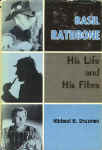 |
Mr. Druxman's book is well-researched and
well-written—a "must have" for every Basil Rathbone fan. The book traces the
fascinating life of the actor and provides detailed descriptions of all of Rathbone's
films, including cast, credits, critics' reviews and production notes.
Out-of-print for more than thirty-five years, Michael Druxman’s book is once again available
for purchase.
This new reprint edition mirrors the original 1975 biography/filmography,
including its more than 250 rare photographs, and also contains a new
Introduction by the author. Buy it at Amazon.com.
|
| In and Out of Character: An Autobiography, by Basil Rathbone (New York: Doubleday, hardcover, 1962). Paperback edition, 2004. | |
| Basil Rathbone proves that he is as good a writer as he
was an actor. In his autobiography Rathbone reveals many facts about his personal life,
and also tells anecdotes about fellow actors and actresses he worked with. This book is
currently available. Check out Amazon.com. |
|








